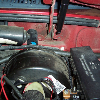Scout3
Well-Known Member
- Joined
- August 19, 2010
- Messages
- 106
- Reaction score
- 0
- City, State
- Orange Park. Fl
- Year, Model & Trim Level
- 97
Just finished working on my son's Explorer. It was missing bad and slowly got worse. Decided to do basic tune up. Changed the plugs and wires. Plugs needed changing and I found one of the wires was open. Runs pretty good now. I also changed the fuel filter. It is a little slow to star so I checked fuel pressure. When you turn the key to run but not starting the pressure only bumps up to about 5psi. Turn the key off and back on and it bumps up higher. When you go ahead and start the engine it goes up to 30psi. If you slowly rev the engine it stays at 30psi. If you romp on it it will go to 40. If you disconnect the vacuum line from the pressure regulator it goes up to 40psi. When you turn the motor off the pressure goes down to zero within about 15 seconds. I cannot crimp the return line closed because it is a braided wire kind of line into a solid metal line.Does it sound like my pump is weak? 30 psi seems kind of low.










